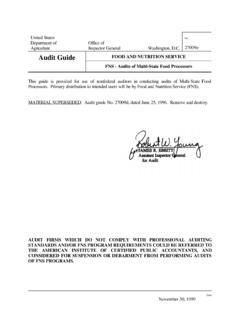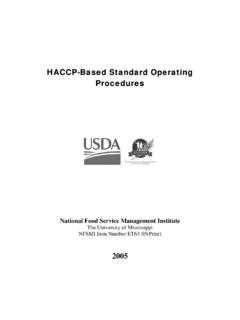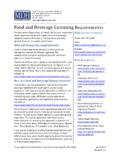Transcription of Washington State’s Basic Food Employment & …
1 Washington State's Basic food Employment & training Program JUNE 2014. AUTHOR. Seattle Jobs Initiative David Kaz, Director of Policy With Rick Krauss ACKNOWLEDGEMENTS. This research by Seattle Jobs Initiative (SJI) was funded by The Annie E. Casey Foundation. We thank them for their support but acknowledge that the findings and conclusions presented in this report are those of the author alone, and do not necessarily reflect the opinions of the Foundation. The author is indebted to the many individuals who have shared their knowledge of Washington 's Basic food Employment & training program, as well as the federal Supplemental Nutrition Assistance Program Employment & training . This report would not have been possible without the generous contributions of time, insight and expertise from the following individuals: John Bowers, South Seattle Community College Marie Bruin, Washington State Board for Community & Technical Colleges Mat Carlisle, Washington State Board for Community & Technical Colleges Amy Crossman, Consultant Dawn Farmer, Edmonds Community College Rachel Gragg, National Skills Coalition Molly Hancock, FareStart Kelli Johnston, Washington State Board for Community & Technical Colleges Matt King, YWCA of Seattle-King-Snohomish Nancy Lucas, Consultant Jen Lyman, Seattle Jobs Initiative Darlene Molsen, Bellevue College Mike Morris, Washington State Department of Social and Health Services Susan O'Callaghan, FareStart Lisa Pan, Washington State Department of Social and Health Services (ORIA).
2 Kathy Payne, Washington State Department of Social and Health Services Mike Schwartz, YWCA of Seattle-King-Snohomish Jeff Sikora, Seattle Goodwill Industries Rosanna Stephens, Seattle Goodwill Industries Jan Strand, Edmonds Community College Jason Turner, Washington State Department of Social and Health Services Bob Watrus, Consultant Heather Worthley, Port Jobs Out-of-state SNAP E&T program research: Aimee Chitayat, formerly of Insight Center for Community Economic Development Claudia Staniszewski, Local Initiatives Support Corporation, Rhode Island Stephanie Stewart, Greater Twin Cities United Way Larry Temple, Texas Workforce Commission The lead author dedicates special thanks to Rick Krauss. This research would not have been possible without his unsurpassed knowledge of the BFET program and major contributions to the completion of this work. TABLE OF CONTENTS.
3 Introduction 1. About SNAP E&T 3. SNAP E&T Legislative Timeline 3. 100 Percent Funding Streams 5. 50-50 Match Funding Streams 6. Activities Supported by SNAP E&T 6. Program Eligibility 7. Performance Accountability 8. What is a Third-Party Match SNAP E&T Model? 9. Planning & Development of Washington State's BFET Program 11. Washington Learns About Potential for Expanded SNAP E&T Program 12. Assessing the Risk/Reward of a Prospective SNAP E&T Pilot 13. Building a Collaborative Pilot Partnership 17. Defining the Pilot Parameters Through a Business Plan 18. Pilot Goals - Ensuring Alignment with DSHS Mission 20. Identifying & Utilizing Champions for the SNAP E&T Pilot 21. Building a Partnership with FNS Western Region 22. The Structure of the BFET Program 24. Program Services Overview 25. Ramping Up DSHS Administrative Staffing Levels for BFET 27. Administrative Functions of DSHS - Eligibility & Billing Processes 28.
4 Administrative Functions of DSHS - Program Management 31. The SBCTC Umbrella Function 34. Office of Immigrant & Refugee Affairs Umbrella Function 36. BFET at the Community Colleges 38. Overview of Fiscal Aspects 38. Overview of Staffing Needs 40. Community College Interviews: Perspectives on BFET 42. Community-Based Organization BFET programs 50. A Note on Mixed Versus BFET-Only programs 50. Profiles of CBO BFET programs 51. CBO Recommendations to Other states Considering SNAP E&T programs 56. BFET Advocacy: Federal- & State-Level Challenges 57. Federal Legislative & Regulatory Changes to SNAP E&T 58. Statewide Legislative & Regulatory Changes to BFET 62. BFET Program Growth & Outcomes 66. Program Expansion 66. Summary of BFET Outcomes 69. Recommendations & Conclusion 73. Appendix A: SNAP E&T programs in Other states 79. End Notes 83. INTRODUCTION. About 47 million people in the United states are now enrolled in the Supplemental Nutrition Assistance Program (SNAP), previously known as the food Stamp Numbers increased significantly during the recent recession and have since remained stable at these higher Most SNAP households face multiple barriers to achieving economic self-sufficiency that will lead them no longer to require SNAP or other public benefits.
5 Chief among these is a lack of marketable skills needed to compete for living-wage jobs in today's rapidly changing labor market. In federal fiscal year (FFY) 2010, for example, about 80 percent SNAP households did not include anyone with education beyond high school, while approximately one-third of these households did not include a high school For these individuals, gaining skills to increase their employability is fraught with challenges, such as a lack of resources, limited knowledge of labor market and training opportunities, 1. low Basic skills, lack of stable housing and transportation, the need for childcare, and the need to work, often full-time, while enrolled in school or training programs . Another challenge faced by SNAP participants in increasing their job skills is the lack of public investment in supporting them in achieving this objective.
6 The nation's primary workforce development program . the Workforce Investment Act (WIA) though it places a focus on low-income populations along with youth and dislocated workers, typically serves a population with fewer barriers than those on SNAP. Regardless, WIA, along with other federal workforce programs , has experienced substantial funding cuts: more than $1 billion in just the past few The Temporary Assistance for Needy Families (TANF). program what is commonly thought of as welfare does serve a population with higher barriers but provides very little support for education and training ; instead, it incents moving participants quickly into what is typically low-wage, unstable Employment . Fortunately, and perhaps surprisingly even for many workforce professionals, SNAP itself supports Employment and training efforts for those enrolled in the program.
7 This is known as Supplemental Nutrition Assistance Program Employment & training (SNAP E&T) or, prior to 2008, as food Stamp Employment & training (FSE&T). SNAP E&T includes several funding streams intended to support states in their efforts to assist their SNAP populations to become economically self-sufficient by providing a variety of Employment and training services. To date, however, most states have made scant use of SNAP. E&T, operating programs that are quite limited in scope and resources. This was true in Washington State up until the mid-2000s. Then, in 2004, a group of government, community college, and community-based organization (CBO) leaders came together in Seattle to imagine how to utilize SNAP E&T in an innovative way to better meet the needs of low-income and low- skill residents for more education and training leading to better jobs.
8 Little did the group know that the model that they were developing known today as Washington 's Basic food Employment & training (BFET) program was something that had not before been attempted. Nor did they know that the BFET program would grow from $150,000 at its launch in October 2005 to more than $29 million today, expanding from Seattle to the entire state, and from one community college and a handful of CBOs to all 34 of the state's colleges and more than 30 CBOs. Over these few short years of rapid growth, BFET has generated positive results for those on Basic food ( Washington 's name for SNAP), demonstrated in the robust data that the BFET program collects to provide evidence of impact and a basis for continuous improvement. The BFET story is one that includes some luck and good timing, innovative and dedicated partners, and multiple programmatic and policy challenges, some of which remain to be addressed.
9 It is a story that, by its telling, might lead other states and localities to envision how they might develop and expand their own innovative SNAP E&T programs , leading more of those individuals in the greatest need out of poverty through improved skills and Employment opportunities. 2. ABOUT SNAP E&T. A comprehensive review of SNAP E&T will not be provided here as two excellent resources are available which offer this information: the federal government's SNAP Employment and training Tool Kit and the National Skills Coalition's SNAP E&T guide, Moving Low-Skill SNAP Recipients Toward However, a Basic overview of SNAP E&T and in particular the program aspects supporting a third-party match model such as BFET will be helpful to provide context for the reader. This section summarizes information from the two aforementioned resources as well as details from the Center for Law and Social Policy's paper, Where the Funds Are: The Use of FSET Funds for Workforce training SNAP E&T LEGISLATIVE TIMELINE.
10 1985: food Security Act is passed, creating the food Stamp Employment & training program (FSE&T, later renamed Supplemental Nutrition Program Employment & training , or SNAP E&T). to provide opportunities for food stamp recipients to improve their Employment prospects and reduce reliance on food stamps. [ food Security Act of 1985, 16 3801-3862]. 1996: A major revision of the FSE&T program is made as part of welfare reform. Total FSE&T. funding is increased and prioritizes Able-Bodied Adults without Dependents (ABAWDs) because these individuals became time-limited in their receipt of food stamps. [Federal Agriculture Improvement & Reform Act of 1996, 104-127; 110 Stat. 888]. 3. FIGURE 1: SNAP E&T LEGISLATIVE TIMELINE. 2008: FSE&T amended by food , Conservation and Energy Act of 2008, and renamed SNAP E&T. 1996: Major revision of the 2012: FCEA extended FSE&T program is made as twice; SNAP E&T 100%.







